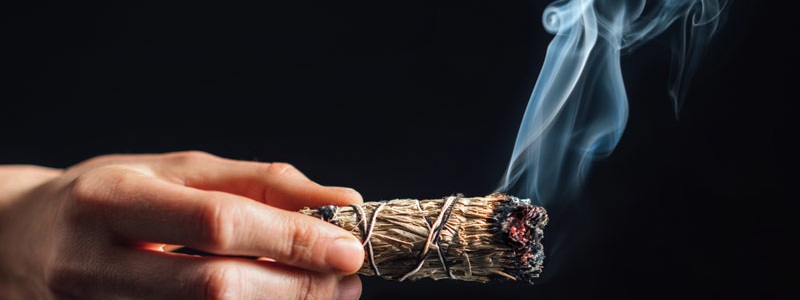by Deborah Frances
Thanks to Herbal Education Services
Herbalist, naturopath, and much revered teacher and elder, Dr. Bill Mitchell once said, that through the process of photosynthesis, plants just naturally bring light into physical form, making them invaluable allies for those who proceed along a spiritual path. Indeed, I know of no tradition in which plants do not play a part.
Genus Artemisia

The four Artemisias common to herbal practice are all, to one degree or another, bitter digestive and liver-stimulating anti-parasitics, and they all contain essential oils. A. tridentata (Sagebrush) and A. vulgaris (Mugwort or River Sage) are the two species used in ceremony, primarily but not exclusively, for smudging, a process where dried herb is lit and the smoke is passed over a person, object, or space for cleansing and blessing. Sagebrush and Mugwort burn best if harvested while in flower.
A. tridentata (Sagebrush)
Sagebrush is abundant in the high deserts of Western North America. The plant is a strong spiritual cleanser with potent essential oils. Matthew Wood tells us the herb is specific for bringing the opposites together, making it a valuable ally to work with ceremonially in these polarizing times. I have had good success using it as a smudge for patients in schizophrenic crises where the soul is scattered. Here it works well when bundled with cedar for grounding.
A. vulgaris (Mugwort, River Sage)
This herb is often used in dream pillows to help us remember our dreams. Used ceremonially, it is specific for cleansing and blessing our dreaming. Named for the Greek Goddess Artemis who assisted in the birth of her twin brother Apollo shortly after her own birth, Mugwort can also be used in ceremonies to encourage fruition of dreams of healing and beauty.
The leaves of Mugwort are softer than those of sagebrush and so too its energy seems gentler, though no less potent by any means. Although Mugwort can be bundled to use as a smudge, I find it burns better when dried leaves are rolled into a ball and lit.
A. absinthium (Wormword)
Do NOT use this herb as a smudge. The essential oils, high in Thujone, can be neurotoxic. The plant may be hung over doorways ritually to ward off parasitic intrusions, and it is a highly effective antiparasitic and anti-malarial when used short term in formula with other antiparasitic herbs. Honestly, Artemesia annua (Sweet Annie, Chinese Wormwood) is probably safer for malaria, where whole herb is preferable to the isolated constituent Artemisinin.
Moving to Other Genus…
The Salvias
Salvia apiana, White Sage, is the herb primarily used in ceremony from this genus, though Salvia officinalis is used by some folks. Also high in essential oils and somewhat antiparasitic when used internally, White Sage is cleansing and uplifting, bringing a sweetness with its properties of purification.
Although White Sage is much loved by many folks, probably because of its sweeter scent, its habitat is largely confined to one area of Southern California. The plants’ wide popularity and easy availability on the market are putting it in serious danger of being over-harvested. The plant is sacred to the Indigenous peoples of that area. Please use another smudge, there are so many to choose from.

Thuja spp. (Cedar)
The leaves of the various species of the evergreen cedar tree make a great smudge. Used alone or tied into a bundle with Sagebrush, Cedar brings grounding and protection as well as purification. Although it does well burned as a smudge stick, it really shines when dried leaves are dropped onto hot coals or the red-hot rocks of the sweat lodge.
Cedar is sacred to Northwest Native tradition where it has been used for clothing, canoes, and shelter as well as ceremony. No wonder Thuja plicata, our Western Red Cedar, has been called the Tree of Life.
Juniperus spp. (Juniper)
The rugged, twisted trunks of the wild mountain or high desert Juniper suggest a stubborn strength to be gathered from this herbal ally. Slightly greenish mostly blue second-year berries must be differentiated from slightly blue mostly green immature first-year berries on harvesting to avoid possible toxicity when taken internally. Medically, Juniper acts as an excellent kidney tonic and although the abundance of essential oils lends antimicrobial properties, the herb has generally been thought to be contra-indicated in the presence of kidney inflammations, making it important to rule out the presence of pyelonephritis when treating acute bladder infection.
Thus, it comes as no surprise that Juniper helps foster discernment. In both harvesting and prescribing, the herbalist must be discerning. The kidneys themselves are organs of discernment, consistently filtering the bloodstream to maintain homeostasis by determining which molecules get excreted and which remain.
Berries are traditionally worn in a medicine bag or ground into a paste to anoint the body for protection. Evergreen leaves tied into a bundle make a strong but sweet-smelling smudge for blessing and purification.
Sweetgrass
Inhalation of essential oils, richly abundant in herbs used as smudges, take our plants’ medicines directly to the limbic system via the olfactory nerve which has an almost instant effect on our emotions. Sweetgrass, woven into a braid and dried for burning is treasured for its uplifting qualities as well as for purification and blessing. It sweetens our homes and sweetens our minds.
Copal
Hailing from south of the US border, Copal resin is another plant that brings purification and sweetness when burned. One Mexican man descended from generations of Curanderas, said he had observed Copal used in healing ceremonies when the threat of death hovered near due to the severity of the illness. Here Copal is thought to call the spirit of the patient back to the land of the living through the cleansing sweetness of its smoke.
Frankincense

Associated with the sun, this resin is traditionally burned at sundown in Egypt to ensure the birth of a new day; a nice ritual for easing the collective despair so many folks feel about the future. (Kudos to Dr. Ken Proefrock ND for sharing that luscious tidbit.)
Over the years I have often prescribed a sun greeting ceremony for depressed patients. A song, a simple prayer giving thanks for the returning light, or an offering can all be done. Practiced regularly this simple ritual can be subtly uplifting.
Myrrh
This resin, also from Egypt, is more associated with the moon and the dreamy inner realms of the Feminine. Both Frankincense and Myrrh are burned on designated Holy Days in the Catholic Church.
Offerings
It’s important to feed the natural world of Spirit. (Spirit being woven through all living beings). Regular offerings help bring us back into relationship with Spirit and Nature.
There are no limits to what an offering can be, but food from our plates and various plants are commonly left as gifts.
Tobacco and corn meal are traditional offerings on Turtle Island and The Little People, as they are known (nature spirits similar to fairies in Europe) love chocolate. Coffee grounds from morning java make another good offering, connecting us to spirit. I often leave Hawthorn leaves and flowers to invite in Spirits of Compassion. Hawthorn is sacred to Celtic traditions. Like the roots of Osha, Hawthorn helps open and protect our hearts to receive the gifts of spirit, though they do so in very different ways.
Tobacco
The use of tobacco was traditionally reserved by Native Americans for prayer and ceremony. A highly addictive, strong plant, Tobacco is what traditionalists might call a “power plant”. Such plants are meant to be used judiciously and with respect, often only in prayer or ceremony.
The medicine of Tobacco is to connect us to Spirit. It is also spiritually protective, aiding to protect our psyches from strong negative influences such as projections or negative emotions directed at us from another person or from a negative environment or circumstance.
When smoked in ceremony, Tobacco is not taken into the lungs but only inhaled into the mouth (or nose in some South American ceremonies). As it is exhaled from the mouth the smoke is often waved over the body as a blessing smudge or blown onto an area of a patient’s body where healing is needed.
Red Willow bark, Lavender, Ura Ursi and Manzanita are other herbs commonly used in prayer smokes, with or without inclusion of Tobacco.
Hypericum perforatum (St John’s Wort)

Hypericum has a strong mythological connection to the sun and is named for the pre-Olympian Greek God of the sun, Hyperion. Long associated with magical traditions in Europe, the bright yellow flowers turn blood red when placed into menstruum for medicine making, reminding us of the life-giving energy of the sun.
St. John’s Wort has spiritually protective qualities that have a special affinity for the reproductive tract. Recognizing that women are more sensitive and open during menses, traditional women in Europe painted their labia with an oil of Hypericum for protection during moontime (menses).
Spiritual Bathing
Aromatic and colorful plants like rose petals, red clover blossoms, calendula, lemon balm, linden and so many others make nice tea for spiritual bathing. Alternatively, specific herbs or herbal blends may be selected to match certain intentions and prayers; St. John’s Wort, Lady’s Mantle, Yarrow, Cedar, and Raspberry Leaf for young women coming of age, Hawthorn, Rose Petals and Linden for the heart, or Yarrow to heal and protect the wounded warrior, healer or highly sensitive individual.
Blue Vervain, Kava, Yarrow, Juniper and a whole host of Ayurvedic herbs specific for the purpose can be applied as either an herbal paste or a few drops of tincture or tea to the third eye. This helps to enhance inner, intuitive vision.
Pine
The flower essence of Pine is well known for its ability to help us heal out of self-blame. Pine boughs or needles can also be laid on an altar to help protect and empower us in the face of blame directed at us from others. Pine may be used to pray for healing in the greater pattern of blame in the collective consciousness as well. Needles can be placed on an altar, used in spiritual bathing or perhaps a tree could be planted in an auspicious place. Dried needles can be ground into a powder to leave as offerings. We might even anoint the third eye with a bit of wet powder, tea, or tincture in supplication that we ourselves may learn to perceive through the lens of “no blame,” as the Chinese Book of Wisdom, the I Ching, consistently advises. We all stumble and fall; it’s part of being human, part of the plan. We’re not even meant to be perfect.
A spritz of Sagebrush to pull us out of polarization, Pine to move us from blame, Hawthorn to keep our hearts protected but open to one another, Cedar to keep us grounded, and Sweetgrass to enable us to lighten up might be just the kind of Holy Water the world needs to journey with grace through these tumultuous times.
May the Beauty of Our Green Growing Relatives Bless You All.

More information on the spiritual gifts of plants combined with a primary focus on medical applications of herbs can be found in Dr. Frances’ book, Practical Wisdom in Natural Healing, available on Amazon. Dr. Frances is currently available for consultations via phone. Sessions are primarily focused on spiritual dimensions in healing. The inclusion of herbs and naturopathic therapies are nearly always part of the mix, vital for grounding spiritual medicine. Dr. Frances can best be reached for appointments at phone number (971) 322-9626 or less optimally by email at Deborah.frances@yahoo.com. Trust me, the phone is far more efficient.





